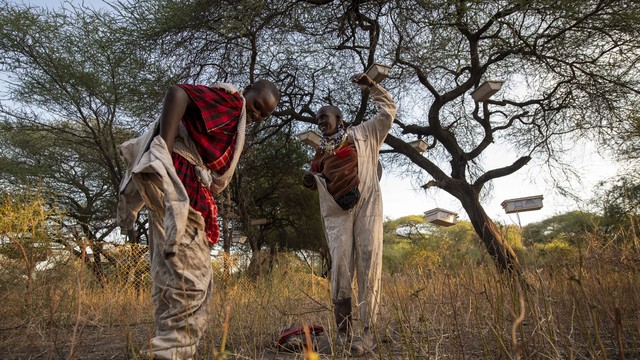Q&A: a message to the Green Climate Fund board
As the Green Climate Fund (GCF) board meets this week to review proposals for the next round of funding, Paul Steele discusses how far the fund is reaching its vision to transform the economies of developing countries for a climate resilient, low carbon future – and how the board can speed up the process of getting finance to those who need it most.

A farmer in Tattaguine, Senegal benefits from an irrigation project. IIED is advocating for the Green Climate Fund to speed up the process of getting finance to local levels, those who need it most (Photo: Ryan Kendrick Smith, Creative Commons, via Flickr)
The GCF has promised a 'paradigm shift' by investing in more ambitious and innovative climate adaptation and mitigation activities. What should this shift look like?
PS: A paradigm shift should push climate action to the centre of public and private investment decisions at both national and local level. And this climate response must be a programmatic approach coordinated by ministries of finance, national development banks and ministries of local government.
For finance ministries this means firmly integrating climate into the budget process, ensuring that climate change is included in fiscal and expenditure policy at national level and in allocations to local governments and municipalities to drive the shift to climate resilient, low carbon development.
Embedding climate change really is the fundamental point here. Unless GCF projects help realign public and private investment, there’s a risk that these GCF projects may be stand-alone islands of success, while the vast majority of the remaining investment does not respond to climate change.
The GCF needs to work with ministries of local government and local organisations to ensure climate finance gets down to the local level – and enable greater voice by the poor and climate vulnerable to prioritise their needs.
IIED is supporting the ministries of local government in Tanzania and Mali to apply for GCF funding to invest in climate funds for local government. Meanwhile, the ministry in Kenya is in the process of submitting a $10m proposal to the GCF to finance four county governments that have set up climate funds – with plans to expand to a further four.
These are exciting precedents being set and should be supported by the GCF.
Shack/Slum Dwellers International is also seeking to apply for GCF funds. This is another exciting innovation – this network of community organisations of the urban poor, mobilising groups of low-income urban residents in more than 33 countries, works to get climate finance to the most vulnerable.
But based on the projects that have been allocated funding so far, the GCF is following a different track. The board is still approving largely conventional aid projects – large-scale infrastructure projects led by multilateral agencies.
It's seven years since the GCF was first proposed at the climate negotiations in Copenhagen ̶ and it’s widely accepted that spending has been too slow. How can things be speeded up?
PS: The GCF has made great progress by raising a US$10 billion budget – a really positive sign. But the challenge now is to use this to approve the game-changing programmes that will really transform economies.
Our message to the board is more speed and less haste. There's been a hasty rush for conventional, low-risk projects from multilateral agencies. The GCF has opened the floodgates to a seemingly random collection of agencies applying for accreditation, leading to delays and frustration.
So while the board has successfully met its funding targets, the wrong kind of projects are receiving the cash and there is no clear strategy for accreditation.
– GCF board must commit to nationally-owned programmes that embed climate into public and private investment decisions
– GCF staff and management need stronger belief and sustained support for a country-led vision and enhanced direct access
– Developing countries must design a nationally driven, programmatic approach – and avoid the temptation to rush to be first in the project queue through support provided by multilateral agencies
The climate change negotiations are notoriously political and tensions often arise between developed and developing countries. How has the 50/50 split on the board affected the GCF? How have they, and can they, be overcome?
PS: North-south divisions have been a challenge for the GCF and can only be overcome by sustained dialogue between board members. Things have become less political since the Paris climate agreement was sealed and there's been a more practical focus on spending the money.
The economies of the Least Developed Countries (LDCs) and African countries are most dependent on climate-sensitive sectors and so are most vulnerable. The GCF must prioritise support to these countries and to those who represent the voices of those who often go unheard.
Now, the real split is less about north versus south and more between those who just want to stick with the traditional view of earmarking money for large, low-risk, business-as-usual projects – and those who really want the GCF to be a catalyst for nationally-owned change.
The GCF aims to 'maximise private sector investments'. What should the role of the private sector be? How effectively do you think the GCF has mobilised the private sector?
PS: The private sector is key to mitigation, especially in middle income countries. So the GCF needs to create incentives for private sector and innovative ways to engage – and not be a substitute for private sector lending and even 'crowding out' private investment.
The GCF can facilitate low carbon private sector investment by creating an enabling environment. This means helping countries make markets attractive by overcoming market failures – removing fossil fuel subsidies, reforming energy prices, or facilitating research and development for clean technologies.
In LDCs, it's small and medium scale enterprises (SMEs) that drive markets and 70 per cent of jobs are in the informal sector ̶ so the GCF should have a clear focus on supporting SMEs.
The GCF can also mobilise private investment in adaptation through facilitating research and development, technology and insurance for climate resilient agriculture and infrastructure.
The focus for private investment in mitigation and adaptation needs to be on unlocking homegrown private finance.
The focus for private investment in mitigation and adaptation needs to be on unlocking homegrown private finance. This finance can come from commercial banks, insurance companies and even high net worth individuals.
Already, some LDCs are taking innovative approaches to finance for climate change such as launching green bonds. The GCF could help such mechanisms get off the ground.
There are concerns that national designated authorities (NDA) – appointed to nominate projects for accreditation – have been side-lined, and many accredited entities are ‘the usual suspects’ (i.e. big multilateral banks). What should be done to address it?
PS: Yes, this is certainly a problem. Of the 15 projects approved so far, 90 per cent have gone to international organisations. The 33 accredited agencies by March 2016 include only three national agencies in LDCs – the Centre de Suivi Ecologique (CSE) in Senegal, Ethiopia's Ministry of Finance and Rwanda's Ministry of Natural Resources.
International organisations are dominating the GCF funds and in doing so undermining national ownership of the climate agenda.
The danger here is that it encourages developing countries to view the climate response as an international obligation – rather than a national political priority. And leadership by the multilaterals means that national and local governments, and small and medium scale entrepreneurs remain as GCF project recipients instead of drivers of a homegrown agenda.
So the GCF needs to be accountable to the NDAs and through them to the citizens of developing countries who are on the frontline of climate change. This means ramping up its engagement with NDAs and providing readiness support to facilitate countries to develop a programmatic approach.
It also needs to rapidly implement enhanced direct access and consider positively the proposal from Namibia in this upcoming board meeting. The GCF will need to avoid any match funding requirement for direct access as this may present challenges for cash-constrained governments.
Local accountability mechanisms are essential for ensuring funding reaches the local level. There needs to be effective monitoring systems put in place by national and local stakeholders to track climate finance to make sure finance gets to where it is needed most.
The big multinational banks are great at generating a project pipeline, but we’re seeing the same process again and again – as we saw in the Global Environmental Facility and Climate Investment Funds. Now the development banks have committed their own core finance for climate and should stick to these internal funds rather than competing with national bodies to access the GCF.
This requires a freeze on giving any more GCF projects to multilateral banks. The GCF could also end the chaotic scramble for accreditation by focusing on strategic national entities, such as national development banks and ministries of local government.
What has the GCF learnt from previous efforts – and how is it getting climate finance to where it's needed most?
PS: The GCF has $10 billion which is more than enough to drive real change. This large capitalisation also allows the GCF to fulfil a key objective of simplifying the complex world of climate finance by providing a single funding pot with a single point of entry.
Yet up until now, the GCF doesn't show signs of fully learning from the past. It's looking too much like a project factory, churning out the same type of projects fought over by the United Nations, World Bank and other aid agencies.
The GCF has $10 billion which is more than enough to drive real change
The GCF is uniquely positioned to really transform economies, but this requires the GCF board and staff to urgently transform themselves so that climate finance gets to those who need it most.
Paul Steele (paul.steele@iied.org) is chief economist at IIED.
Contact
Paul Steele is chief economist at IIED


